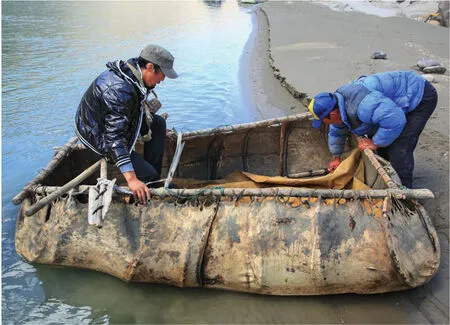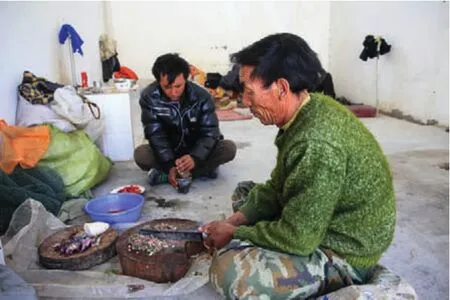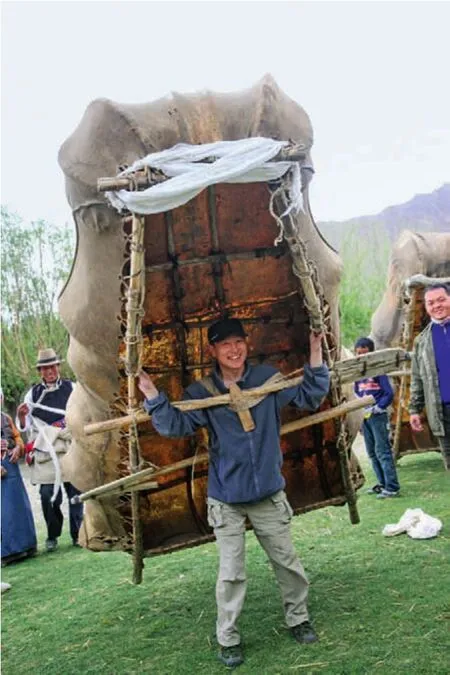Plateau Fishing Community
By LU MINGWEN
Plateau Fishing Community
By LU MINGWEN
F ISH is more or less absent from the Tibetan diet, because in local culture it is revered as a godly creature. But this is not the case in Gyongba, a rural community in Quxur County, Lhasa, where fishing has been a major means to a living for generations.
At daybreak each morning, Soinam Cering, 28, and his brother Purbu Cering, 26, set out from Gyongba for Nyemo County, and travel 70 km to the upper reaches of the Yarlung Zangbo River. There they cast their fishing nets. They make the journey on two motorcycles, one of which has a side car to transport their catch and fishing equipment.
Older residents of Gyongba say that catching and eating fish is customary here because long ago the amount of fish in the Lhasa River suddenly spiked, and moreover grew wings. As more and more of these weird creatures ascended to the skies they blocked the sunlight, so endangering the existence of other beings. The gods instructed the Gyongba people, led by a hunter named Bala Zinba, to eradicate these devilish creatures. After a bloody fight lasting nine days and nights, the Gyongba people won. They celebrated by feasting on the enemy. Fish thus became part of the local diet.
A more prosaic explanation lies in the hamlet’s topography. Situated on the lower reaches of the Lhasa River, Gyongba is surrounded on three sides by mountains, and has the river on its fourth. With limited access to the rest of the region and scant farmland, fishing was Gyongba residents’ sole means of subsistence.
After an hour or more, the Cering brothers arrive at the banks of the Yarlung Zangbo River. Before going to work, they prepare their lunch – minced raw fish and roasted barley. The fish is skinned and finely chopped, and mixed with shallots and radishes, red chili powder, salt, and water.

Soinam Cering and his brotherPurbu Cering at work in their boat.
After this time-consuming but enjoyable lunch, the brothers haul their yak skin boat, which weighs 30 to 40 kg, into the river. Soinam steers the skiff, and Purbu casts the net. The first haul brings in a handsome 30-plus fish. They call it a day after four or five trawls. Soinam pulls the boat onto the bank and suns it,while Purbu cleans the net and sorts out their tools.

A family makes minced raw fish, a local delicacy.
PLaTEau fIShINg
In the past most Gyongba residents subsisted on fishing. Owing to dwindling stocks in the Lhasa River and exposure to a more modern economy, they now have a more diversified lifestyle.

A tourist hoists a yak skin boat.
In the past most Gyongba residents subsisted on fishing. Owing to dwindling stocks in the Lhasa River and exposure to a more modern economy, they now have a more diversified lifestyle.
According to village chief Tashi, Gyongba has 380 residents living in 80 households, with per capita farmland of two mu (15 mu equals one hectare). Some of them still fish. Others work in the field, make artifacts, or look for work outside the region.
Cering, 57, handcrafts small scale models of the local yak skin boats in his yard using sheepskin and bamboo strips. He can finish one in three hours. They sell in the market for RMB 50 or more.
Cering and his brother run a small workshop in the village and hire a dozen workers at peak season. Besides the model boats they also produce purses, dice pads (leather pads on which to roll dice), and various bags.
Fishing has irrevocably shaped the local indigenous culture and customs. Another example is the Yak Skin Boat Dance. Zhabsang, 78, is the village’s only Ara, or lead Yak Skin Boat Dancer. During the performance he wields a pole bearing multi-colored flags, called a tata, while singing and dancing. Meanwhile four to six men bob in choreographed steps while carrying a 30-40 kg yak skin boat, which they tap with paddles to the rhythm of their movements.
Before the democratic reform in Tibet of 1959 the Gyongba people were made to work in long-distance waterage as corvee for the local government. As the yak skin boats could not sail against the tide, fishermen drifted in their boats from the upper reaches of the river to their destination. There they sunned their boats before setting off on foot, carrying the vessels back to the starting point. During the long days on water and trudging over land, the fishermen invented boat songs and dances to entertain themselves. They are of two types, one is slow and idyllic, conjuring the sight of a broad, calm river surface and fleeting clouds, sung during smooth sailing; the other is wordless with a rapid rhythm and sharply undulating pitches, sung when struggling against storms.
The Yak Skin Boat Dance is in four acts. The first is a monologue by the Ara, or lead dancer. The second act is the Yak Dance, where the lead dancer sings the Song of Blessing to the accompaniment of the other dancers’ drumming of their yak skin boats. In the third act, called Picking up the Khata, the lead dancer takes a Khata – a ceremonial scarf – and places it on the ground. The other dancers bow and pick it up on the horns at the fore of the boat. The last act is the Song of Blessing.
In 2008 the Gyongba Yak Skin Boat Dance was listed as national intangible cultural heritage. Both the dance and yak skin boats are now big tourist attractions at the village. The Gyongba Holiday Resort central building, eight km from the village, is in the shape of a yak skin boat. In addition to local specialties, such as various fish dishes, barley wine, and buttered tea, the resort also offers performances of the Yak Skin Boat Dance and yak skin boat tours.
LU MINGWEN is a reporter for the Tibet Business newspaper.

